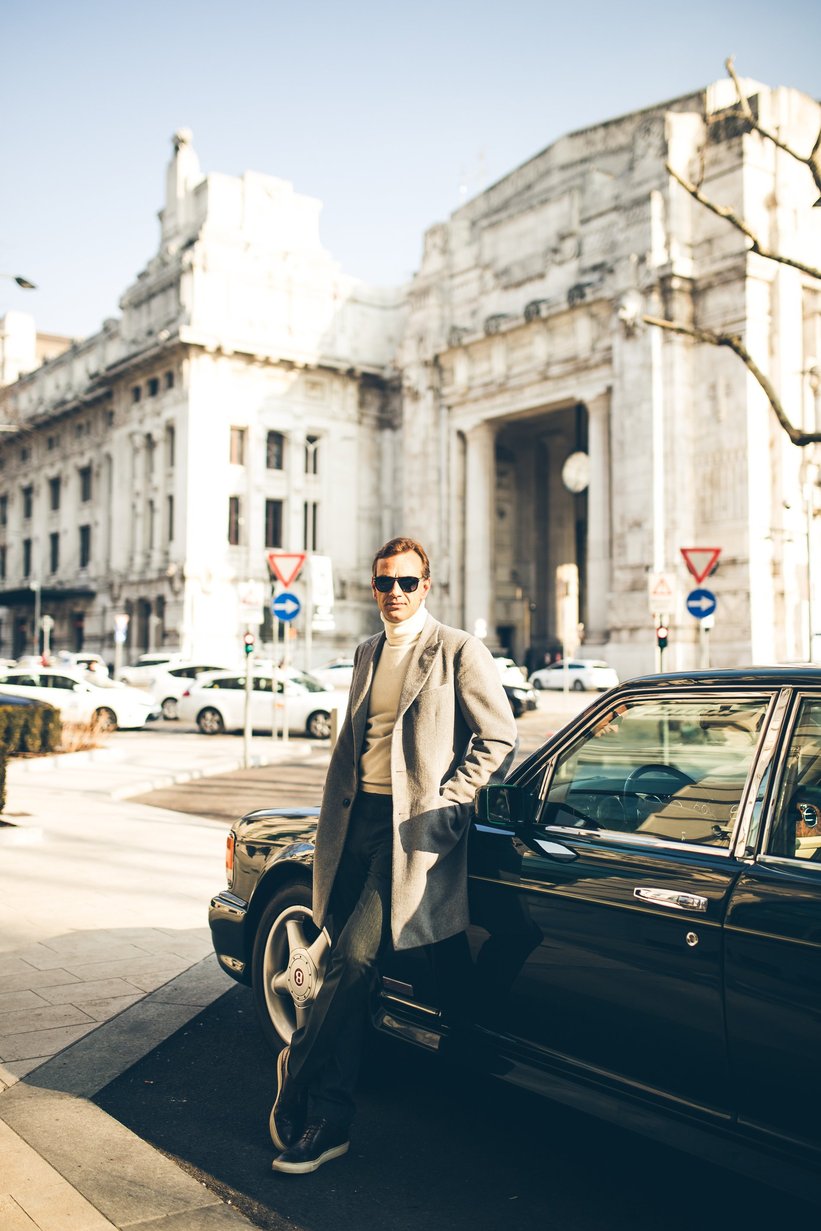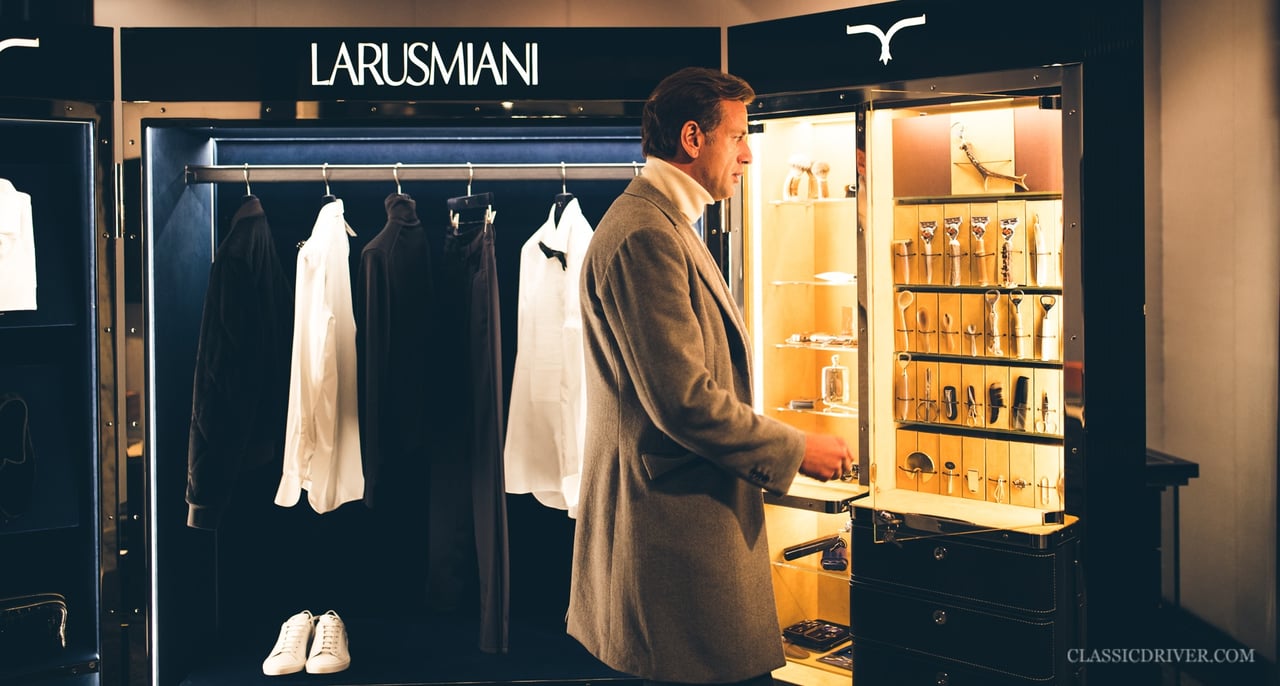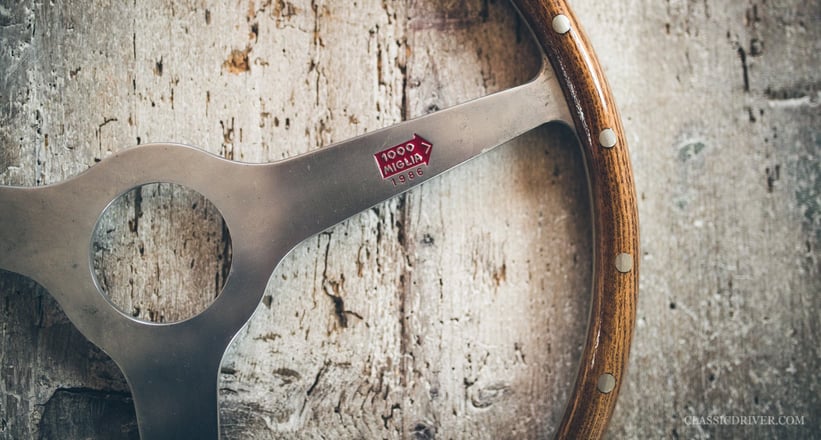

Even before we arrive at Milano Centrale on a sunny January afternoon, it’s pretty obvious that Guglielmo Miani is a man of action. In a few brief emails and phone conversations, the fashion entrepreneur and car collector has advised us on the lighting conditions and locations for our photoshoot, booked us into a grand hotel, cleared a parking spot in his private garage, set up a production plan cleverly incorporating his own tight schedule, and organised dinner with his friend, the car collector and potential Lancia saviour Eugenio Amos. Now, Guglielmo is casually leaning against a dark green Bentley Turbo across from Milan's old train station, sporting Steve McQueen Persols, a Bamford Patek Philippe, and a light grey angora wool coat over a white cashmere turtleneck, smoking a roll-up cigarette and smiling broadly when he recognises us.
The Bentley pick-up service for customers who come into town for the fitting of a new suit is one of the many details that set Larusmiani apart from most other Italian fashion houses. With French house music pumping from the speakers, we settle in the rear seats and marvel at the Mulliner specs and the speedometer next to the foldout whisky bar. First on the schedule is driving to the Montenapoleone store, Larusmiani's headquarters in the heart of the Milanese fashion district. “Do you want to take photos during the drive?” asks Guglielmo, and before we can even respond, he has hailed an Uber and instructed the driver in rapid Italian on how to operate a camera car. The man clearly runs at his own pace.



What’s the story behind your family’s fashion brand, Larusmiani?
Larusmiani was created in 1922, when my grandfather opened a tailor shop in Via Manzoni. Under the name of ‘Larus’ — Latin for seagull — he handcrafted suits, jackets, coats, and raincoats, and soon started importing British fabrics, which, at that time, were the most precious and beautiful fabrics in the world. What he didn’t need for himself, he sold to other tailors. Until the 1950s and 1960s, you had to go to a tailor if you wanted to dress properly, and during these years my grandfather became the largest importer of British fabrics in Italy. Then, prèt-a-porter became a trend, and he produced his first handmade ready-to-wear collection. When my father joined the company in the late 1950s, he added his own line of less formal and more modern and fashionable Italian fabrics to the portfolio. That’s when Larusmiani turned from a tailor and textile importer into a textile producer for the Italian fashion industry. We basically did the opposite of what Loro Piana, Etro, and Ermenegildo Zegna did, which all started with their own fabrics and then later created their fashion brands and stores.
After 12 years running the textiles division, you took over the brand from your father in 2012. What changes have you made?
Since taking Larusmiani into my own hands, I have lead the creative development of the brand and given it my personal touch. Today, I consider Larusmiani to be a gentlemen’s destination. Apart from that, we still run our tailor shop in Tuscany, where 40 tailors work by hand, just like my grandfather did. And we acquired the know-how from Aldo Lorenzi of the legendary cutler store G. Lorenzi — the oldest brand on Via Montenapoleone, which was opened in 1929 and located just on the opposite corner of Larusmiani.



G. Lorenzi was a Milanese institution. Can you tell us a bit more about the family behind it and the products which you now sell at Larusmiani?
Giovanni Lorenzi considered himself a knife artisan, but, in fact, he was a genius with many talents. He not only produced beautiful knives, but he also found the best cutlers from all over the world and sold their knives in his shop. From knives, he moved to shaving kits and then added smoking accessories, such as cigar cutters and boxes, games, and other elegant gentleman’s items to his range. We’re happy that we could save this tradition under the Larusmiani roof. Today, we’re the only place in the world where you can order bespoke S.T. Dupont lighters — the best lighters you can have, custom made in France according to your wishes. Everything a gentleman desires, from tailored clothes to shaving knives and cigar humidors, can be found here.
And in terms of the fashion you produce, what is your philosophy?
Larusmiani’s idea of luxury is understated but not boring. Many items have a ‘dandy’ twist. These velvet house robes, for instance, have been produced for 20 years — today, people wear them at parties and on the street. And the same with silk pyjamas, which are very popular as well. People like to wear these iconic gentlemen’s items in new contexts. And we love to tweak the traditions of tailoring. But at the same time, we can tailor the perfect classic suit with our own fabrics. It all depends on your personal style.



From the store, we head over the road for a quick coffee at Pasticceria Cova, another Milanese landmark that just celebrated its 200th anniversary. With its marble counters, waiters in white jackets, old silverware, chandeliers, and sugar-powdered pastries, the bar seems like a time capsule in which Lombardic ‘grandezza’ has been preserved for the ages.
You’re the president of the Montenapoleone district, where all major luxury brands have their flagship stores. What makes this neighbourhood so special?
The Montenapoleone district is something you need to experience. You’re basically standing in the epicentre of Italian fashion. And here, the Italian lifestyle, which is so famous around the world, is very much alive — from this bar to the restaurants, hotels, and stores around us. This is all natural. It’s not Disneyland. It’s our way of life. I find it very convenient that you can move around in a radius of 800 metres and discover all the different collections and limited editions that have been produced only for the Milanese stores of Prada, Gucci, and so on. You don't find these things in Japan or China. That's why the savviest shoppers come here.

Can you please tell us a bit more about the green Bentley Turbo in which we just arrived?
It’s a Bentley Turbo RT Mulliner from 1998 — the last of only 55 built by Mulliner’s interior designer Darren Day, who personally consulted with every client. It took me years to find. I stumbled upon it on a French website that rented out wedding cars. I am very passionate about cars from the 1990s — in fact, all my Bentleys were built in 1998.
What’s so special about these 1990s Bentleys?
When I was a teenager, I adored seeing them lined-up in front of the Monte-Carlo Beach Club. Later, when I got into 1990 cars again, I realized how much rarer the Bentleys were than the Ferraris of the same time. Also, they were the last truly hand-built cars before the Volkswagen take-over. As a maniac for everything handmade, I instantly knew that these were my cars. After I bought my first one, a very special all-black Continental R Mulliner SE from Berlin, I just kept searching for more.



Of course, Guglielmo Miani not only works in the Montenapoleone district, he also lives just a couple of minutes away from the Larusmiani store. Stepping out of the elevator into his penthouse overlooking Milan, we are astonished by his eclectic collection of artwork, photographs, design objects, and automotive books – as well as a Honda Four parked next to his couch. Oh, and did we mention the body of a full-scale Autodelta Alfa Romeo prototype casually attached to a mirrored wall? The perfect setting to dig a bit deeper into the history of Guglielmo’s automotive socialisation.
When did your passion for cars start?
My father wasn’t into cars, but my godfather — his name is Renato della Valle — was a three-time offshore powerboat world champion, and he was crazy about anything that had an engine. He also built the famous Montecarlo Offshorer speed boat that was the continuation of the Riva Aquarama in the 1980s. I remember he had a house with 40 Ferraris in his garage. It was he who fuelled my passion for cars.



What was your first car?
The first car I drove was my father’s white Mini Moke in Sardegna — I was about 14 years old when he let me try it on an open road. As a teenager, I was a bad student, and when I finally managed to pass my exams, my father bought me my first car: a black BMW M3 Sport Evo 2. When I moved to Babson College outside Boston to study entrepreneurship and finance, I left the car in Milan. I just had a bicycle and, after nine months, I was going crazy. One day, I saw this red Corvette with a red interior in a dealership, and when they told me it only cost 500 dollars per month, I immediately signed the deal. Of course, my father had a meltdown when he heard about it and sent over my BMW by plane. I drove the car around Boston for half a year with Italian plates. One day, I counter-steered quite fast into Newbury Street and suddenly a police car was behind me. Being a young and hot-tempered Italian, I put my foot down. They came after me but didn’t catch me. I hid somewhere and didn’t use the car for a month — then, I changed the plates. I later sold the car to a bond trader in New York for twice the original price.


What’s the story of the machines in your living room?
Over here is an original Autodelta Tipo 33 body, which I bought at an auction. The Honda belonged to my father. My mother asked him to sell it and he told her he did — but later I found it in one of our company’s warehouses. I had it cleaned and now display it as a work of art.
Are there any other cars that you would like to add to your collection?
I’ve always loved Alfa Romeo’s history, and I’ve owned a 164 in the past, as well as a beautiful two-door 147 in Cumberland Grey with a beige leather interior. Tomorrow, I will be looking at my carpenter’s SZ — he bought it new and never used it. It’s the only Alfa from the 1990s that really excites me. And in the end, it’s not right if a car guy from Milan doesn’t own an Alfa Romeo (laughs).
Photos: Tom Shaxson for Classic Driver © 2018





























































































